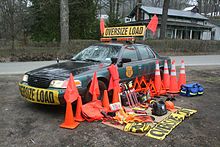- Oversize load
-
 Typical Pilot Car / Escort / Flag Car in the United States
Typical Pilot Car / Escort / Flag Car in the United States
In road transport, an oversize load (or overweight load) is a load that exceeds the standard or ordinary legal size and/or weight limits for a specified portion of road, highway or other transport infrastructure, such as air freight or water freight. There are also load per axle limits. However, a load that exceeds the per-axle limits, but not the overall weight limits, is not considered overweight. Examples of oversize/overweight loads include construction machines (cranes, front loaders, backhoes, etc.), pre-built homes, containers, construction elements (bridge beams, generators, windmill propellers, industrial equipment).
The legal dimensions and weights vary between countries and regions within a country. A vehicle which exceeds the legal dimensions usually requires a special permit which requires extra fees to be paid in order for the oversize/overweight vehicle to legally travel on the roadways. The permit usually specifies a route the load must follow as well as the dates and times during which the load may travel.
Contents
International perspectives
In a specific country the roads are built in a way that allows a vehicle with dimensions within the standard legal limits to safely (though not necessarily easily) drive and turn. Roads that do not allow large vehicles may be marked with the traffic signs. These may include per-axle load, height, width, or overall length limits.
In the United States an oversize load is a vehicle and/or load that is wider than 8' 6". Each individual state has different requirements regarding height and length (most states are 13' 6" tall), and a driver must purchase a permit for each state he/she will be traveling through. In many states, a load must be considered "nondivisible" to qualify for a permit (e.g., an object which cannot be broken down into smaller pieces), although some states allow divisible loads to be granted permits.[1]
Signaling
Typically, the edges of any oversize load must be marked to make them visible to drivers. During daytime the required marking is usually red flags, and during night white or yellow lights may be used. The hauling vehicle must have at least one flashing amber light in the front and back. Signs (yellow with black border in the United States, red and white diagonal stripes in the EU, and red and white vertical stripes in Canada), saying "Oversize load" must be put in the front and back of the vehicle. [2]
A pilot and trailing cars are required also. They must have at least one flashing amber light on them. Their purpose is to warn drivers about what's approaching. The pilot car warns drivers in the opposite lane to move away, and the trailing car warns any candidates to overtake. The driver of the pilot car must have a voice link with the driver of the truck to warn him or her about any low bridges, wires, obstacles, etc. The driver of the trailing car is responsible for the safety while passing obstacles or overtaking slower vehicles. [3]eA pilot car is often called an escort vehicle or flag car and is a marked vehicle with warning signs and lights that operates in front of or behind a large vehicle that exceeds normal vehicle dimenstions in height, length, width and/or overhang. The escort vehicle protects the oversize load, and warns and protects other roadway users. Pilot Car / Escort drivers help to:
- Make highways safer for the drivers of the oversize load and public
- Prevent damage to the roadway system
- Prevent damage to the loads that are being transported
- Reduce delays in the normal flow of traffic
- Minimine the increases in insurance costs though preventing crashes
Since the driver of the truck has no visual on the end of the trailer or any possible vehicles in the next lane (because the load obstructs the mirrors), the general procedure is as follows: The truck driver sees an obstacle and signals with his left (or right, if in a left-side traffic country) blinker. The driver of the trailing car waits until the adjacent lane is clear and moves so that the truck driver sees his or her car, thus preventing anyone from standing next to the truck. Then the trailing car moves a little back to stay clear of the truck's path. As soon as the trailer has cleared the obstacle, the trailing car again moves forward and flashes its headlights to inform the truck driver that it's safe to return in their lane.[original research?] A pilot car driver may temporarily block traffic at intersections to ensure the safe passage of the truck. [4]
Licensing
Different countries have different approaches to licensing oversize/overweight loads. Licenses may be issued for a specific load, for a period of time, or to a specific company.
See also
External links
References
- ^ "Oversize and Overweight Load Permit Information". Federal Highway Administration. http://ops.fhwa.dot.gov/freight/sw/permit_report.htm. Retrieved 2009-04-18.
- ^ "Oversize and Overweight Pilto Car Escort Service". Pat's Pilot Car Service. http://certifiedescort.com. Retrieved 2009-04-18.
- ^ "Oversize and Overweight Pilto Car Escort Service". Pat's Pilot Car Service. http://certifiedescort.com. Retrieved 2009-04-18.
- ^ "Oversize and Overweight Pilto Car Escort Service". Pat's Pilot Car Service. http://certifiedescort.com. Retrieved 2009-04-18.
Categories:- Commercial item transport and distribution
- Road transport
Wikimedia Foundation. 2010.



